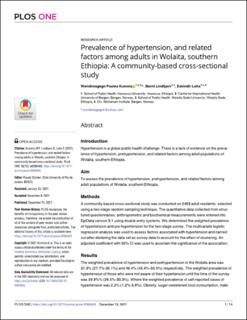Prevalence of hypertension, and related factors among adults in Wolaita, southern Ethiopia: A community-based cross-sectional study
Journal article, Peer reviewed
Permanent lenke
https://hdl.handle.net/11250/2835292Utgivelsesdato
2021-12-01Metadata
Vis full innførselSamlinger
- Publications [1488]
Originalversjon
in Plos One vol. 16 no. 12 10.1371/ journal.pone.026040310.1371/journal.pone.0260403
Sammendrag
Introduction Hypertension is a global public health challenge. There is a lack of evidence on the prevalence of hypertension, prehypertension, and related factors among adult populations of Wolaita, southern Ethiopia.
Aim To assess the prevalence of hypertension, prehypertension, and related factors among adult populations of Wolaita, southern Ethiopia.
Methods A community-based cross-sectional study was conducted on 2483 adult residents, selected using a two-stage random sampling technique. The quantitative data collected from structured questionnaires; anthropometric and biochemical measurements were entered into EpiData version 3.1 using double-entry systems. We determined the weighted prevalence of hypertension and pre-hypertension for the two-stage survey. The multivariate logistic regression analysis was used to assess factors associated with hypertension and carried out after declaring the data set as survey data to account for the effect of clustering. An adjusted coefficient with 95% CI was used to ascertain the significance of the association.
Results The weighted prevalence of hypertension and prehypertension in the Wolaita area was 31.3% (27.7%-35.1%) and 46.4% (42.9%-50.0%) respectively. The weighted prevalence of hypertension of those who were not aware of their hypertension until the time of the survey was 29.8%% (26.5%-33.3%). Where the weighted prevalence of self-reported cases of hypertension was 2.2% (1.2%-3.8%). Obesity, sugar-sweetened food consumption, male sex, elevated total cholesterol, raised fasting blood sugar, and advancing age were positively associated with hypertension.
Conclusion The prevalence of hypertension among adults in Wolaita was high. A small proportion of the affected people are aware of their high blood pressure. This study reported a high prevalence of pre-hypertension; which indicates a high percentage of people at risk of hypertension. It is essential to develop per
Serie
Plos One vol. 16 no. 12Plos One vol. 16 no. 12
